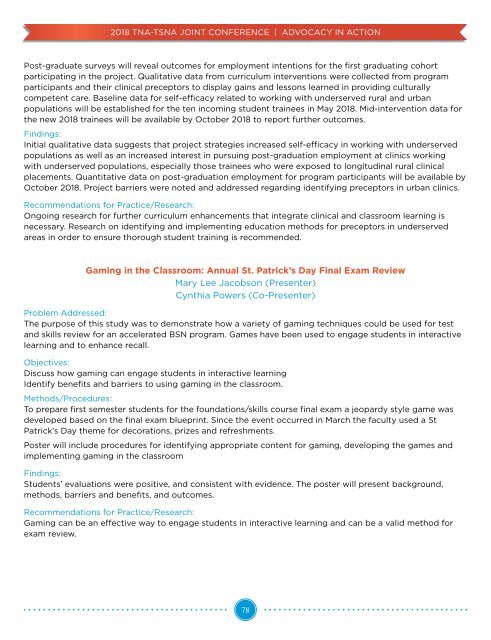2018 TNA and TSNA Joint Annual Conference
You also want an ePaper? Increase the reach of your titles
YUMPU automatically turns print PDFs into web optimized ePapers that Google loves.
<strong>2018</strong> <strong>TNA</strong>-<strong>TSNA</strong> JOINT CONFERENCE | ADVOCACY IN ACTION<br />
Post-graduate surveys will reveal outcomes for employment intentions for the first graduating cohort<br />
participating in the project. Qualitative data from curriculum interventions were collected from program<br />
participants <strong>and</strong> their clinical preceptors to display gains <strong>and</strong> lessons learned in providing culturally<br />
competent care. Baseline data for self-efficacy related to working with underserved rural <strong>and</strong> urban<br />
populations will be established for the ten incoming student trainees in May <strong>2018</strong>. Mid-intervention data for<br />
the new <strong>2018</strong> trainees will be available by October <strong>2018</strong> to report further outcomes.<br />
Findings:<br />
Initial qualitative data suggests that project strategies increased self-efficacy in working with underserved<br />
populations as well as an increased interest in pursuing post-graduation employment at clinics working<br />
with underserved populations, especially those trainees who were exposed to longitudinal rural clinical<br />
placements. Quantitative data on post-graduation employment for program participants will be available by<br />
October <strong>2018</strong>. Project barriers were noted <strong>and</strong> addressed regarding identifying preceptors in urban clinics.<br />
Recommendations for Practice/Research:<br />
Ongoing research for further curriculum enhancements that integrate clinical <strong>and</strong> classroom learning is<br />
necessary. Research on identifying <strong>and</strong> implementing education methods for preceptors in underserved<br />
areas in order to ensure thorough student training is recommended.<br />
Gaming in the Classroom: <strong>Annual</strong> St. Patrick’s Day Final Exam Review<br />
Mary Lee Jacobson (Presenter)<br />
Cynthia Powers (Co-Presenter)<br />
Problem Addressed:<br />
The purpose of this study was to demonstrate how a variety of gaming techniques could be used for test<br />
<strong>and</strong> skills review for an accelerated BSN program. Games have been used to engage students in interactive<br />
learning <strong>and</strong> to enhance recall.<br />
Objectives:<br />
Discuss how gaming can engage students in interactive learning<br />
Identify benefits <strong>and</strong> barriers to using gaming in the classroom.<br />
Methods/Procedures:<br />
To prepare first semester students for the foundations/skills course final exam a jeopardy style game was<br />
developed based on the final exam blueprint. Since the event occurred in March the faculty used a St<br />
Patrick’s Day theme for decorations, prizes <strong>and</strong> refreshments.<br />
Poster will include procedures for identifying appropriate content for gaming, developing the games <strong>and</strong><br />
implementing gaming in the classroom<br />
Findings:<br />
Students’ evaluations were positive, <strong>and</strong> consistent with evidence. The poster will present background,<br />
methods, barriers <strong>and</strong> benefits, <strong>and</strong> outcomes.<br />
Recommendations for Practice/Research:<br />
Gaming can be an effective way to engage students in interactive learning <strong>and</strong> can be a valid method for<br />
exam review.<br />
78

















